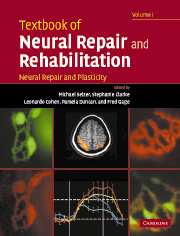Book contents
- Frontmatter
- Contents
- Contents (contents of Volume II)
- Preface
- Contributors (contributors of Volume I)
- Contributors (contributors of Volume II)
- Neural repair and rehabilitation: an introduction
- Section A Neural plasticity
- Section A1 Cellular and molecular mechanisms of neural plasticity
- 1 Anatomical and biochemical plasticity of neurons: regenerative growth of axons, sprouting, pruning, and denervation supersensitivity
- 2 Learning and memory: basic principles and model systems
- 3 Short-term plasticity: facilitation and post-tetanic potentiation
- 4 Long-term potentiation and long-term depression
- 5 Cellular and molecular mechanisms of associative and nonassociative learning
- Section A2 Functional plasticity in CNS system
- Section A3 Plasticity after injury to the CNS
- Section B1 Neural repair
- Section B2 Determinants of regeneration in the injured nervous system
- Section B3 Promotion of regeneration in the injured nervous system
- Section B4 Translational research: application to human neural injury
- Index
2 - Learning and memory: basic principles and model systems
from Section A1 - Cellular and molecular mechanisms of neural plasticity
Published online by Cambridge University Press: 05 March 2012
- Frontmatter
- Contents
- Contents (contents of Volume II)
- Preface
- Contributors (contributors of Volume I)
- Contributors (contributors of Volume II)
- Neural repair and rehabilitation: an introduction
- Section A Neural plasticity
- Section A1 Cellular and molecular mechanisms of neural plasticity
- 1 Anatomical and biochemical plasticity of neurons: regenerative growth of axons, sprouting, pruning, and denervation supersensitivity
- 2 Learning and memory: basic principles and model systems
- 3 Short-term plasticity: facilitation and post-tetanic potentiation
- 4 Long-term potentiation and long-term depression
- 5 Cellular and molecular mechanisms of associative and nonassociative learning
- Section A2 Functional plasticity in CNS system
- Section A3 Plasticity after injury to the CNS
- Section B1 Neural repair
- Section B2 Determinants of regeneration in the injured nervous system
- Section B3 Promotion of regeneration in the injured nervous system
- Section B4 Translational research: application to human neural injury
- Index
Summary
Introduction
If the ultimate aim of neural repair and rehabilitation is to restore functions vital to an individual's ability to live independently, then restoration of the capacity to learn and remember is of tremendous importance. The ability to learn, including the acquisition of novel information, relationships and strategies, and the ability to remember and act upon what has been learned, are essential for successful negotiation of our dynamic environment. While many behaviors are reflexive, stereotyped and innate, experience and memory shape much of our behavioral repertoire and allow us to perform basic tasks essential to our daily life by recognizing familiar faces, locating our homes, etc. Understanding how new information is encoded at the neural level and made accessible for later recall is a central goal of neuroscience. How are constellations of sensory input transformed into usable information, interpreted within a context, and remembered? Clearly, there must be causally relevant neural correlates of learning and memory that once identified should provide insight into the fundamental mechanics of brain organization and function. If we can understand how the brain changes in response to experience and thus how it is that we can learn and remember, then we will be well equipped to address many of the most devastating deficits resulting from brain injury.
Keywords
- Type
- Chapter
- Information
- Textbook of Neural Repair and Rehabilitation , pp. 26 - 43Publisher: Cambridge University PressPrint publication year: 2006

